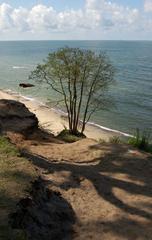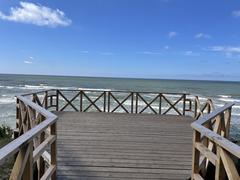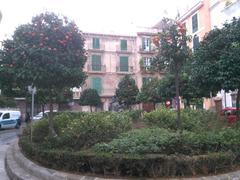
Visiting Hours and Tickets for Olando Kepurės Skardis in Klaipeda City
Date: 18/07/2024
Introduction
Olando Kepurės Skardis, also known as the Dutchman’s Cap, is a stunning and historically significant natural landmark in Klaipeda City, Lithuania. This coastal cliff, part of the Seaside Regional Park, is renowned for its breathtaking geological formations, rich history, and diverse ecology. Formed approximately 10,000 years ago during the last Ice Age, Olando Kepurės Skardis stands as a testament to the powerful forces of nature that sculpted Lithuania’s coastline (Seaside Regional Park). The cliff’s distinctive shape has served as a vital landmark for sailors navigating the Baltic Sea, earning it a place in local folklore and maritime history. Today, it captivates visitors with its panoramic views, outdoor activities, and educational programs, making it a must-visit destination for nature enthusiasts and history buffs alike.
Table of Contents
- Introduction
- Geological Formation and Early History
- Cultural and Historical Significance
- World War II and Post-War Era
- Modern-Day Significance
- Visitor Information
- Environmental and Conservation Efforts
- Visitor Experience and Educational Programs
- FAQ
- Conclusion
Geological Formation and Early History
Olando Kepurės Skardis is part of the Seaside Regional Park, established in 1992 to protect the unique coastal landscape and biodiversity. The cliff was formed approximately 10,000 years ago, during the last Ice Age, when retreating glaciers sculpted the landscape, leaving behind moraines and other glacial formations that characterize the region today (Seaside Regional Park).
Cultural and Historical Significance
The name “Olando Kepurės” translates to “Dutchman’s Cap,” referencing the cliff’s distinctive shape. Sailors navigating the Baltic Sea used the cliff as a landmark, highlighting its historical importance to seafaring communities. In the 19th and early 20th centuries, the area became a popular destination for locals and visitors, known for its scenic beauty and panoramic Baltic Sea views. The cliff also holds a place in local folklore, adding to its allure.
World War II and Post-War Era
During World War II, Olando Kepurės Skardis was strategically significant and used by both German and Soviet forces for military purposes. Remnants of wartime fortifications and bunkers remain, offering a glimpse into the region’s turbulent past (Klaipeda Tourism).
Modern-Day Significance
Today, Olando Kepurės Skardis is a protected natural monument and a popular tourist destination. Standing at approximately 24 meters high, the cliff offers breathtaking views of the Baltic Sea and the surrounding landscape. It is part of the Seaside Regional Park, spanning over 50 kilometers of coastline and featuring diverse habitats like dunes, forests, and wetlands.
Visitor Information
Visiting Hours
Olando Kepurės Skardis is open year-round. However, the best times to visit are during the spring and summer months when the weather is favorable, and the flora and fauna are at their peak.
Tickets
There is no entrance fee to visit Olando Kepurės Skardis. However, guided tours and special events may have associated costs. Check the Seaside Regional Park website for the latest information on tours and events.
Travel Tips
- Accessibility: The cliff is accessible by car, bike, or public transportation from Klaipeda City. Parking is available near the site.
- Nearby Attractions: While visiting, explore other attractions in Klaipeda, such as the Curonian Spit, Klaipeda Castle, and the Lithuanian Sea Museum.
- What to Bring: Comfortable walking shoes, a camera, and binoculars for birdwatching.
Environmental and Conservation Efforts
The Seaside Regional Park is dedicated to conserving the area’s natural resources and biodiversity. Efforts include protecting fragile coastal ecosystems from erosion, pollution, and human impact. Various measures, such as installing protective barriers and restoring natural vegetation, are being implemented to mitigate erosion and preserve the cliff (Lithuanian Geological Survey).
Visitor Experience and Educational Programs
The park offers a range of activities and educational programs. Guided tours and nature walks provide insights into the geological history, flora, and fauna of the region. Educational programs raise awareness about conservation and the importance of protecting natural landscapes. The park also hosts events and workshops on birdwatching, marine biology, and environmental conservation, engaging the community and visitors in hands-on learning experiences.
FAQ
What are the visiting hours of Olando Kepurės Skardis?
- The site is open year-round, with the best visiting times during spring and summer.
How much are tickets for Olando Kepurės Skardis?
- There is no entrance fee, but guided tours and special events may have costs.
What nearby attractions should I visit?
- Explore the Curonian Spit, Klaipeda Castle, and the Lithuanian Sea Museum.
Conclusion
Olando Kepurės Skardis offers an unparalleled blend of natural beauty, historical depth, and ecological significance, making it a standout destination in Klaipeda City. Whether you’re drawn by the dramatic cliffs rising 24 meters above the Baltic Sea, the rich history dating back to World War II, or the diverse flora and fauna, this site promises a memorable experience for all visitors. The ongoing conservation efforts by the Seaside Regional Park ensure that this natural treasure is preserved for future generations, while educational programs and guided tours offer deeper insights into its geological and cultural heritage (Lithuanian Geological Survey). By practicing responsible tourism and engaging with the local community, visitors can contribute to the preservation and appreciation of Olando Kepurės Skardis. Make sure to explore nearby attractions, participate in activities like birdwatching and hiking, and enjoy the natural splendor of this unique coastal landmark.
References
- Seaside Regional Park, 1992, Seaside Regional Park
- Klaipeda Tourism, 2024, Klaipeda Tourism
- Lithuanian Geological Survey, 2024, Lithuanian Geological Survey
- Lithuanian Ornithological Society, 2024, Lithuanian Ornithological Society




